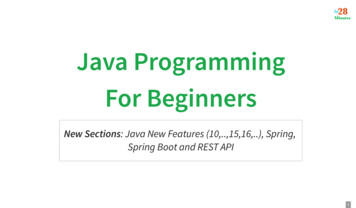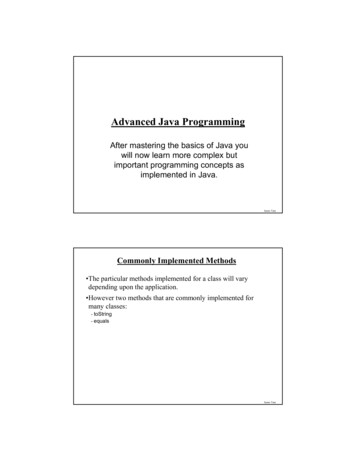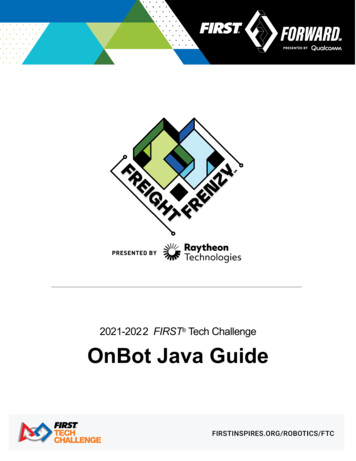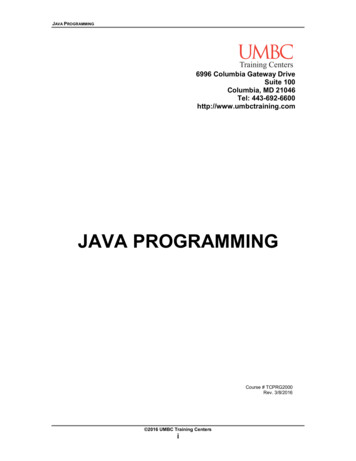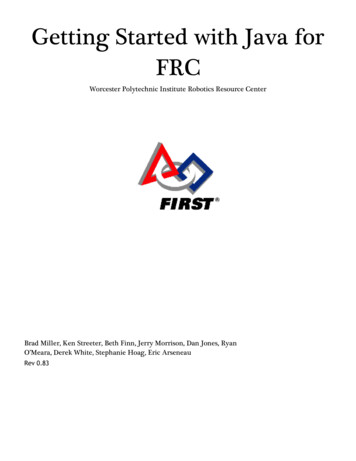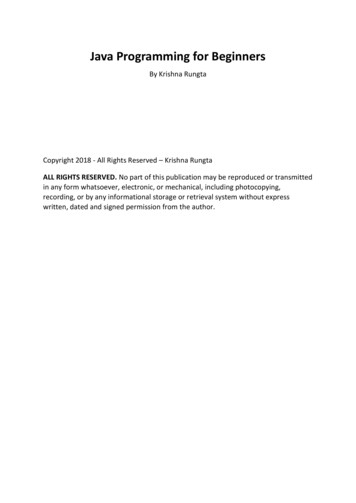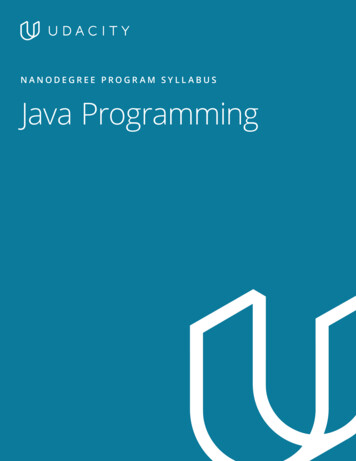
Transcription
NANODEGREE PROGR AM SYLL ABUSJava ProgrammingNeed Help? Speak with an Advisor: www.udacity.com/advisor
Java Programming Nanodegree ProgramBUILD AND DEPLOY JAVA APPLICATIONS AT SCALEThis Nanodegree program is intended to elevate your Java abilities and teach you the fundamental skills used by Javadevelopers to design, code, test and deploy cutting-edge Java software. It is ideal for programming beginners withlittle or no Java experience who want to set themselves up for success as a professional Java developer and deployfunctional Java-based applications of their own creation.A graduate of this program will be able to: Apply basic features of Java programming language (data types, variables, conditional statements, loops,methods) to develop applications Use IntelliJ IDE to develop and troubleshoot Java applications Design and create classes and class methods in a Java application Apply interfaces, inheritance and polymorphism in Java applications Select and use Collections (lists, maps, sets, etc.) and basic features of functional programming (lambdas,streams, Optional) to organize and process data Apply advanced concepts (reflection, class loading, etc.) to implement advanced Java applicationsPrerequisites:No prior Java experience is required, but you should be familiar with basic programming concepts like variables,loops, conditionals, arrays and methods.Length ofProgram*:3 monthsTextbooksrequired:NoneFrequency ofClasses:The program isflexible, self-pacedwith suggestedproject deadlinesInstructional ToolsAvailable:Video lectures,mentor-led studentcommunity, forums,project reviews*This program includes 3 courses and 3 projects. Each project you complete will be an opportunity to grow yourprogramming portfolio and will demonstrate to potential employers that you have skills in these areas.Need Help? Speak with an Advisor: www.udacity.com/advisorJava Programming 2
Course 1: Java FundamentalsIn order to be a great Java developer you must first learn the fundamentals of Java. This course introduces thefundamental concepts and practices of Java programming. These include basic Object-oriented Programming(OOP) concepts such as classes, encapsulation and inheritance, as well as core Java concepts such as collections,exceptions and commonly used Java types.Project 1Hotel ReservationApplicationStudents will be designing and implementing a hotel reservationapplication. The hotel reservation application will allow customersto find and book a hotel room. Rooms will contain the price alongwith the dates that the room is reserved. All room bookings will beassociated with a single customer account, the customer accountwill include the customer name (first and last) and email. Theapplication will allow customers to retrieve a list of the hotel’s freerooms. In addition, the hotel reservation application will allowcustomers to find and book rooms based on availability and price.SUPPORTING LESSON CONTENTLESSON ONELESSON TWOJava ProgrammingBasics Understand keywords and how they are used in Java. Be able to declare variables in Java. Describe the difference between primitive variables andobjects. Apply casting to change the type of a variable into anothertype. Understand what truncation is and why it occurs. Create a method in Java. Describe the difference between Stack and Heap memory. Know the four different access modifier types. Create an array to store primitive variable types. Create each of the three different loops (While, do While andFor) to iterate over an array. Create a Java program in IntelliJ. Describe the purpose of Javadoc.Defining Classes Explain what an object is and why we use them. Describe the differences between a class and an object. Know the parts and syntax for creating a class. Create different objects from a specific object type. Describe the purpose of Garbage Collection in Java.Need Help? Speak with an Advisor: www.udacity.com/advisorJava Programming 3
SUPPORTING LESSON CONTENTLESSON THREELESSON FOURLESSON FIVELESSON SIXObject-OrientedProgramming Describe what packages are in Java and why we use them. Apply Inheritance to share behavior and state between relatedclasses. Apply polymorphism in Java to support decoupling. Describe the difference between an Interface and Abstractclass.Common Type Apply throwing an Exception from a method when an issueis discovered. Create an Exception Handler to catch and handle an Exception. Use Enums to provide a predefined selection of constants. Use the Java Scanner class to read input from the console. Apply Java Data and Calendar class to store and manipulateday and time. Use the Java RegEx package to validate the input of a String. Use some of the advanced methods of the String class tocreate substring, search for text and investigate differentcharacters of a string.Generics andCollectionsAdvanced JavaTypes Describe the purpose of using Generics in Java. Create a generic method that processes different class typeswithout casting. Apply generics to Collections to create stronger type data sets. Use data structures that implement the Collection interface. Use the Collections utility class to sort a list of Strings. Use Maps to store and retrieve data based on a key value. Use Sets to remove duplicate values from a List. Use a Queue to store values in a FIFO manner.Need Help? Speak with an Advisor: www.udacity.com/advisorJava Programming 4
Course 2: Advanced Java Programming TechniquesThe best Java programs combine excellent software designs with modern language features. This coursewill teach you some lesser known features of Java, such as functional programming, I/O, serializationand reflection. Strengthen your software design intuition by exploring the design ideas that underpinunderstandable, extensible and scalable software systems. Learn the basic concepts and techniques ofconcurrent programming in Java, so your programs can take advantage of modern, multi-core hardware.Project 2Legacy Web CrawlerConcurrency is a powerful tool to increase the performance of yourJava programs. In this project, you’ll use concurrent programmingtechniques to enhance a legacy web crawler so that it can takeadvantage of multi-core architectures. The crawler will readconfiguration from a JSON file, download and parse multiple HTMLdocuments in parallel and record popular web terms in an outputfile. You’ll also build a method profiling tool to measure the efficiencyof the crawler and prove the benefits of the parallel crawler.SUPPORTING LESSON CONTENTLESSON ONELESSON TWOLESSON THREEFunctionalProgramming inJava Understand the differences between imperative andfunctional programming. Use functional interfaces, lambdas and method referencesto simplify and improve your Java code. Apply Java’s Stream API to perform quantitative analysis overlarge sets of data.Working with Filesand I/O Understand the differences between program memory andpersistent storage. Know the different uses of binary and encoded data andunderstand when to use each. Use the Java Files API to read and write files. Recognize different kinds of resource leaks and apply modernJava techniques to prevent them. Serialize and deserialize between Java objects and commonformats like JSON, XML and binary.Design Patterns Identify the principles of good software design and buildstrong software design intuition. Understand what design patterns are and why they are useful. Use Creational, Behavioral and Structural design patterns towrite flexible and easy-to-understand code. Apply Dependency Injection to simplify object creation andpromote testable designs.Need Help? Speak with an Advisor: www.udacity.com/advisorJava Programming 5
SUPPORTING LESSON CONTENTLESSON FOURLESSON FIVEReflection Use reflection and annotations to introspect and adddynamic capabilities to your programs. Implement Java interfaces at runtime using dynamic proxies. Understand the fundamentals of Aspect OrientedProgramming. Use class loaders to customize how Java loads byte code.Introductionto ConcurrentProgramming Recognize when concurrency can help improve theperformance of Java programs. Use threads, thread pools and parallel streams to achieveparallelism in Java. Apply Java synchronization tools to correctly share statebetween threads in a parallel program.Need Help? Speak with an Advisor: www.udacity.com/advisorJava Programming 6
Course 3: Java Application DeploymentThis course introduces Java ecosystem topics that are necessary to develop production-ready applications.It starts by covering the construction and makeup of Java program artifacts. You will learn how Java programcode is compiled, packaged and executed. Next, you’ll learn how to use Maven to automate and customize thebuild process, as well as manage external project dependencies. This course also covers the topic of Modules,introduced in Java 9. In addition to build topics, this course will also teach you to use the tools of JUnit 5 to writeunit tests and evaluate code coverage. To expand our testing capabilities for complex applications, the Mockitolibrary and test doubles will be covered as well.To practice all the skills covered in this course, you’ll start withan existing project that needs help. The UdaSecurity programis a basic GUI application that allows users to perform varioustasks related to managing their home security system. In order toprepare to scale the software, it’s going to need some revisions.You’ll need to refactor the program into a multi-module Mavenproject and you’ll also be writing unit tests to verify that it actuallydoes what it claims to do. You’ll be using the JUnit 5 and Mockitolibraries we cover in this course to write a full unit test suite forthe project.Project 3UdaSecuritySUPPORTING LESSON CONTENTLESSON ONELESSON TWOLESSON THREERunning JavaApplications Learn to use the tools of the JDK to compile, package and runJava applications. Recognize and evaluate bytecode. Use the JShell application to execute arbitrary Java code.DependencyManagement withMaven Read and write well-formed XML, including Maven pom.xmlfiles. Use Maven to build Java projects and include externaldependencies. Use Maven plugins to modify the build process and performadditional tasks such as generating API documentation andexecuting static code analysis.Java Modules Identify and create Java 9 modules using the ModuleDescriptor class. Convert existing projects into module format. Use the JLink tool to create a custom JRE for a specific Javamodule.Need Help? Speak with an Advisor: www.udacity.com/advisorJava Programming 7
SUPPORTING LESSON CONTENTLESSON FOURLESSON FIVEUnit Testing withJava Explain the benefits of automated testing and identify thesteps in the unit testing lifecycle. Write unit tests utilizing the features of JUnit 5 to cover allprogram requirements. Run unit tests automatically with Maven. Use tools in IntelliJ to identify any missing code coveragefrom your unit tests.Mocking andIntegration Testing Identify and create test doubles to isolate testing requirementsfrom their dependencies. Use the Mockito library to create and modify the behavior oftest doubles. Understand the roles of Unit Testing, Integration Testing andFunctional testing in the automated testing process. Create mock endpoints using Wiremock to isolate testingrequirements from external API calls.Need Help? Speak with an Advisor: www.udacity.com/advisorJava Programming 8
Our Classroom ExperienceREAL-WORLD PROJECTSBuild your skills through industry-relevant projects. Getpersonalized feedback from our network of 900 projectreviewers. Our simple interface makes it easy to submityour projects as often as you need and receive unlimitedfeedback on your work.KNOWLEDGEFind answers to your questions with Knowledge, ourproprietary wiki. Search questions asked by other students,connect with technical mentors, and discover in real-timehow to solve the challenges that you encounter.WORKSPACESSee your code in action. Check the output and quality ofyour code by running them on workspaces that are a partof our classroom.QUIZZESCheck your understanding of concepts learned in theprogram by answering simple and auto-graded quizzes.Easily go back to the lessons to brush up on conceptsanytime you get an answer wrong.CUSTOM STUDY PLANSCreate a custom study plan to suit your personal needsand use this plan to keep track of your progress towardyour goal.PROGRESS TRACKERStay on track to complete your Nanodegree program withuseful milestone reminders.Need Help? Speak with an Advisor: www.udacity.com/advisorJava Programming 9
Learn with the BestJeff PhillipsDustin HellsternS E N I O R S O F T WA R E E N G I N E E RS O F T WA R E E N G I N E E RJeff has a Master’s in Computer Scienceand over 20 years of experience. He hasworked on embedded avionics flightcontrols systems for both Honeywell andBoeing. Later in his career, he moved intoJava Cloud based SAAS applications.Dustin is a software engineer with 15years of Java experience, including over 7years designing and building large-scalesystems for one of the top companies inthe tech industry. He is excited to sharehis knowledge with you in this program.Alex PritchardS E N I O R S O F T WA R E E N G I N E E RAlex is a Senior Software Engineer forCPA Global. He is excited to combine hisbackground as a music educator withmore than a decade of enterprise Javaexperience to help create this hands-oncourse about testing and deploying Javaapplications.Need Help? Speak with an Advisor: www.udacity.com/advisorJava Programming 10
All Our Nanodegree Programs Include:EXPERIENCED PROJECT REVIEWERSREVIEWER SERVICES Personalized feedback & line by line code reviews 1600 Reviewers with a 4.85/5 average rating 3 hour average project review turnaround time Unlimited submissions and feedback loops Practical tips and industry best practices Additional suggested resources to improveTECHNICAL MENTOR SUPPORTMENTORSHIP SERVICES Questions answered quickly by our team oftechnical mentors 1000 Mentors with a 4.7/5 average rating Support for all your technical questionsPERSONAL CAREER SERVICESC AREER SUPPORT Resume support Github portfolio review LinkedIn profile optimizationNeed Help? Speak with an Advisor: www.udacity.com/advisorJava Programming 11
Frequently Asked QuestionsPROGR AM OVERVIE WWHY SHOULD I ENROLL?Java is one of the most popular computer programming languages today. Javadevelopers are in serious demand. In fact, there are hundreds of thousandsof open job opportunities posted on job boards currently. This programwas designed to help you take advantage of the growing need for skilledprogrammers.WHAT JOBS WILL THIS PROGRAM PREPARE ME FOR?By the time you graduate, you’ll be prepared to land a high-paying roleproducing web applications in a professional setting. You’ll learn more thanjust writing code. For example, this Java class also teaches students to designand prototype apps using UI best practices to maximize engagement. OtherJava tutorials are more piecemeal learning, but this will stand up a junior javadeveloper so they can hit the ground running on a development team.HOW DO I KNOW IF THIS PROGRAM IS RIGHT FOR ME?This is an entry level Nanodegree program that teaches the basics ofJava programming to individuals who are already familiar with computerprogramming and are looking to advance their careers in programming.ENROLLMENT AND ADMISSIONDO I NEED TO APPLY? WHAT ARE THE ADMISSION CRITERIA?No. This Nanodegree program accepts all applicants regardless of experienceand specific background.WHAT ARE THE PREREQUISITES FOR ENROLLMENT?No prior Java experience is required, but you should be familiar with basicprogramming concepts like variables, loops, conditionals and methods. Youshould be comfortable running applications on Windows, MacOS or Linux.Need Help? Speak with an Advisor: www.udacity.com/advisorJava Programming 12
FAQs ContinuedIF I DO NOT MEET THE REQUIREMENTS TO ENROLL, WHAT SHOULD I DO?Though no Java experience is required, you may want to prepare with ourfree What is Programming course or our Intro to Programming Nanodegreeprogram.TUITION AND TERM OF PROGR AMHOW IS THIS NANODEGREE PROGRAM STRUCTURED?The Java Programming Nanodegree program is comprised of content andcurriculum to support three projects. We estimate that students can completethe program in three months, working five to ten hours per week. Each projectwill be reviewed by the Udacity reviewer network. Feedback will be provided,and if you do not pass the project, you will be asked to resubmit the projectuntil it passes.HOW LONG IS THIS NANODEGREE PROGRAM?Access to this Nanodegree program runs for the length of time specifiedabove. If you do not graduate within that time period, you will continuelearning with month to month payments. See the Terms of Use and FAQs forother policies regarding the terms of access to our Nanodegree programs.CAN I SWITCH MY START DATE? CAN I GET A REFUND?Please see the Udacity Program Terms of Use and FAQs for policies onenrollment in our programs.SOF T WARE AND HARDWAREWHAT SOFTWARE AND VERSIONS WILL I NEED IN THIS PROGRAM?There are no software and version requirements to complete this Nanodegreeprogram. All coursework and projects can be completed via StudentWorkspaces in the Udacity online classroom.Need Help? Speak with an Advisor: www.udacity.com/advisorJava Programming 13
Use the Java Scanner class to read input from the console. Apply Java Data and Calendar class to store and manipulate day and time. Use the Java RegEx package to validate the input of a String. Use some of the advanced methods of the String class to create substring, search f


